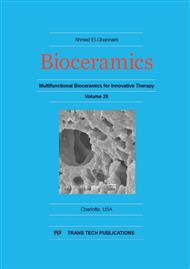[1]
S. V. Dorozhkin, Calcium orthophosphate-based biocomposites and hybrid biomaterials, J. Mater. Sci., 44 (2009) 2343–2387.
DOI: 10.1007/s10853-008-3124-x
Google Scholar
[2]
S. V. Dorozhkin, Calcium orthophosphates in nature, Biology and Medicine, Materials, 2 (2009) 399–498.
DOI: 10.3390/ma2020399
Google Scholar
[3]
C. Ohtsuki, T. Ichikawa, H. Shibata, G. Kawachi, T. Torimoto, S. Ogata, Sensing of protein adsorption with a porous bulk composite comprising silver nanoparticles deposited on hydroxyapatite, J. Mater. Sci., Materials in Medicine, 21 (2010).
DOI: 10.1007/s10856-009-3982-z
Google Scholar
[4]
T. Kawasaki, K. Ikeda, S. Takahashi, Y. Kuboki, Further study of hydroxyapatite high-performance liquid chromatography using both proteins and nucleic acids, and a new technique to increase chromatographic efficiency, Eur. J. Biochem., 155 (1986).
DOI: 10.1111/j.1432-1033.1986.tb09483.x
Google Scholar
[5]
T. Kawasaki, S. Takahashi, K. Ikeda, Hydroxyapatite high-performance liquid chromatography: column performance for proteins, Eur. J. Biochem., 152 (1985) 361–371.
DOI: 10.1111/j.1432-1033.1985.tb09206.x
Google Scholar
[6]
D. T. H. Wassell, R .C. Hall, G. Embery, Adsorption of bovine serum albumin onto hydroxyapatite, Biomaterials, 16 (1995) 697–702.
DOI: 10.1016/0142-9612(95)99697-k
Google Scholar
[7]
M. R. Mucalo, K. Kato, Y. Yokogawa, Phosphorylated, cellulose-based substrates as potential adsorbents for bone morphogenetic proteins in biomedical applications: A protein adsorption screening study using cytochrome C as a bone morphogenetic protein mimic, Colloids Surf. B: Biointerfaces, 71 (2009).
DOI: 10.1016/j.colsurfb.2009.01.004
Google Scholar
[8]
Y. Fujishiro, H. Yabuki, K. Kawamura, T. Sato, A. Okuwaki, Preparation of needle-like hydroxyapatite by homogeneous precipitation under hydrothermal conditions, J. Chem. Tech, Biotechnol., 57 (1993) 349–353.
DOI: 10.1002/jctb.280570409
Google Scholar
[9]
H. Zhang, Y. Yan, Y. Wang, S. Li, Thermal Stability of Hydroxyapatite Whiskers Prepared by Homogenous Precipitation, Adv. Eng. Mater., 4 (2002) 916–919.
DOI: 10.1002/adem.200290003
Google Scholar
[10]
K. Kandori, N. Horigami, A. Yasukawa, T. Ishikawa, Texture and Formation Mechanism of Fibrous Calcium Hydroxyapatite Particles Prepared by Decomposition of Calcium–EDTA Chelates, J. Am. Ceram. Soc., 80 (1997) 1157–1164.
DOI: 10.1111/j.1151-2916.1997.tb02958.x
Google Scholar
[11]
A. Jillavenkatesa, R. A. Condrate, Sr., Sol–gel processing of hydroxyapatite, J. Mater. Sci., 33 (1998) 4111–4119.
DOI: 10.1023/a:1004436732282
Google Scholar
[12]
X. Lu, Z. Zhao, Y. Leng, Calcium phosphate crystal growth under controlled atmosphere in electrochemical deposition, J. Cryst. Growth, 284 (2005) 506–516.
DOI: 10.1016/j.jcrysgro.2005.07.032
Google Scholar
[13]
R. R. Rao, H. N. Roopa, T. S. Kannan, Solid state synthesis and thermal stability of HAP and HAP–β-TCP composite ceramic powders, J. Mater. Sci. Mater. Med., 8 (1997) 511–518.
DOI: 10.1080/0371750x.1998.10804835
Google Scholar
[14]
I .S. Neira, F. Guitian, T. Taniguchi, T. Watanabe, M. Yoshimura, Hydrothermal synthesis of hydroxyapatite whiskers with sharp faceted hexagonal morphology, J. Mater. Sci., 43 (2008) 2171–2178.
DOI: 10.1007/s10853-007-2032-9
Google Scholar
[15]
I. S. Neira, Y. V. Kolen'ko, O. I. Lebedev, G. V. Tendeloo, H. S. Gupta, F. Guitia´n, M. Yoshimura, An effective morphology control of hydroxyapatite crystals via hydrothermal synthesis, Cryst. Growth Des., 91 (2009) 466–474.
DOI: 10.1021/cg800738a
Google Scholar
[16]
F. Nagata, Y. Yamauchi, M. Tomita, K. Kato, Hydrothermal synthesis of hydroxyapatite nanoparticles and their protein adsorption behavior, J. Ceram. Soc. Japan, 121, 9 (2013) 797–801.
DOI: 10.2109/jcersj2.121.797
Google Scholar
[17]
K. Kandori, M. Saito, T. Takebe, A. Yasukawa, T. Ishikawa, Adsorption of bovine serum albumin on synthetic carbonate calcium hydroxyapatite, Colloids Surf. B: Biointerfaces, 5 (1995) 81–87.
DOI: 10.1016/0927-7765(95)98210-e
Google Scholar
[18]
S. Koutsopoulos, Synthesis and characterization of hydroxyapatite crystals: A review study on the analytical methods, J. Biomed. Mater. Res., 62 (2002) 600–612.
DOI: 10.1002/jbm.10280
Google Scholar


